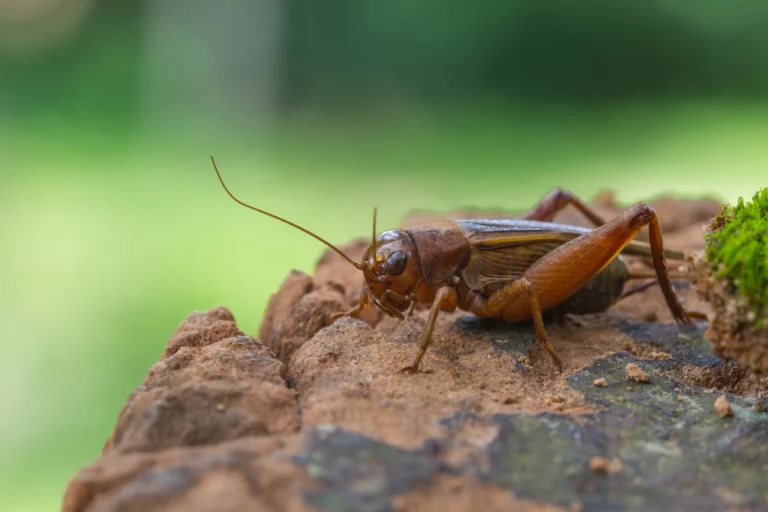
House Crickets
What are House Crickets?
House crickets are so-called because they frequently take up residence in human dwellings, where they can potentially live permanently, hence the name. This species of cricket originally hails from Europe, but it has since been brought to the entire United States.
Intriguingly, the males attract females by making a loud chirping sound by rubbing their front wings together.
House Crickets Identification
What Do House Crickets Look Like?
The heads of adult house crickets are triangular and dark brown with three dark crossbands. They measure around 3/4 to 7/8 inches in length, with wings that are folded flat on their backs, and have threadlike antennae that are typically longer than their body. In every other way, nymphs and adults look alike, save that the former lack wings.
Signs of an Infestation
House crickets themselves are the most noticeable indicator of an infestation. They’re attracted to the warm, damp conditions found within buildings. Chirping sounds made by male house crickets can be heard when they brush their front wings together, which is another indication of a cricket infestation. Their “calling song” is meant to woo potential mates, and as they are nocturnal, it typically takes place after dark. This chirping could be an indication of an infestation of house crickets if homeowners are hearing it. House crickets can cause fabric damage by chewing on it. When looking closely, you can sometimes make out the mandible markings along the chewed edges. There is little more than a millimeter of space between these blotches.
House Crickets Prevention
How To Get Rid Of House Crickets
Reducing sources of moisture around the home is the most efficient method of eliminating crickets and preventing future infestations. Trim the grass, pull weeds, and stack wood away from the house. Basements, crawl spaces, and similar areas need proper ventilation. Consider installing yellow light bulbs or sodium vapor lights outside to make them less noticeable. Window and door frames, as well as any cracks or openings in the masonry, should be sealed to prevent house crickets from entering the home. To get rid of house crickets and their eggs, you can also use a vacuum.
What Do House Crickets Eat?
House crickets get their nutrition from plants and other insects (both living and dead) when they are released into the wild. The fabric in furniture, clothing, and carpet is fair game for these pests when they’re inside. House crickets love to feast on wool, cotton, silk, synthetic, and perspiration-stained clothing.
House Crickets Education
Habitat
In the warmer months, house crickets venture outside, where they frequent trash cans and other waste containers. They congregate on vertical surfaces like lampposts and home walls after being drawn to electric lights in enormous numbers, sometimes numbering in the millions. In the winter, however, they seek the shelter of homes and outbuildings for the sake of the added humidity and warmth they provide.
Habits
House crickets are nocturnal, meaning they are most active at night, and spend the daytime hiding out in dark, warm areas. House crickets are primarily nocturnal indoor pests, but they migrate outside during warmer months, where they can be found in gardens, parks, and garbage cans. They congregate on vertical surfaces like lampposts and home walls after being drawn to electric lights in enormous numbers, sometimes numbering in the millions. When the weather turns cold, though, they head indoors, where the moisture and warmth can keep them alive.
Threats
House crickets don’t pose a threat to human health, but they can destroy your belongings, especially anything made of fabric like clothes, rugs, and upholstery. Wool, cotton, silk, and synthetics are among the most-preferred textiles. House crickets are often found on the surface, where they feed and leave a roughened surface as they pluck loose threads. Large swaths of fabric can be eaten away by an infestation. For this reason, cricket extermination should be a high priority.
Frequently Asked Questions
When it comes to pest control, many people believe it is best to wait until there is a problem before taking action. At this stage, exterminating bugs may be both expensive and inconvenient for you. Because of the savings you’ll save on future treatments as well as the assurance that your house is bug-free, preventive pest control is an excellent investment.
It is common for pest control treatments to include a wide range of products. In order to provide you with the best possible solution, an expert will perform an in-depth assessment of your house. Conventional pesticide treatments are often used in pest management, depending on the specifics of your circumstance.
We recommend contacting our office to get a quote for your specific pest control requirements since the level of infestation and the surrounding environment affect the price.
On Demand does NOT charge for inspections. Our objective is to provide each customer with a personalized strategy. We know where to look for certain types of bugs, and we will perform a full inspection to find them. Additionally, we will also check for any other type of pest that may have made their way into your home. Each strategy takes into account the specifics of the property, issue, and the surrounding area. You may request an inspection by contacting (954) 947-0805.
